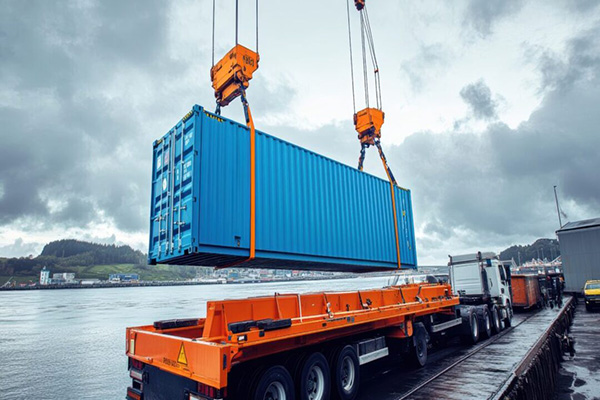Manufacturers who harness aftermarket intelligence to navigate the complexities of tariffs will position themselves for long-term growth.

By Claire Rychlewski, Chief Revenue Officer, Syncron
In the wake of sweeping new U.S. tariffs, OEMs need to rapidly rethink their pricing, supply chain, and business models as the ripple effects spread throughout global supply networks. The uncertainty of new and evolving tariffs puts pressure on manufacturers to accelerate digital transformations and build agility to react to market conditions and support revenue growth. Companies that successfully pivot will thrive despite the uncertainty of new and evolving tariff rates. Slow-moving businesses will struggle.
One immediate impact of the administration’s new tariffs is clear: higher costs will compel companies to defer new capital investments and maintain existing equipment longer. This shift places greater importance on the aftermarket as a growth engine and profit center for manufacturers while simultaneously making effective service delivery more challenging.
We’re seeing a fundamental restructuring of aftermarket operations. As companies delay purchasing new equipment, maintaining uptime for existing assets—whether vehicles, industrial machinery, or agricultural equipment—becomes mission-critical and places greater importance on spare parts
The effects are already evident across industries. Within just one week of auto industry imports tariff enforcement on Canada and Mexico, experts estimate that one-third of North American vehicle production could face disruption, translating to more than 20,000 vehicles per day lost due to parts shortages. Replacement automotive parts could see cost increases between 25% and 100%.
For manufacturers, this creates a delicate balance. As equipment ages, more maintenance will be needed to support the machines that keep our world running. So, service experiences will increasingly make or break brand loyalty for future purchases. Yet delivering exceptional service grows more difficult when parts are harder to source, and costs are rising.
The challenge comes to a head with warranty and service contract fulfillment. Sudden tariff increases on automotive parts imports raise the cost of honoring existing agreements, creating a difficult choice: either absorb the higher costs and sacrifice margins or pass increases along to customers and risk driving them toward third-party repair options or competitive brands.
Manufacturers that simply pass along all cost increases to customers may preserve short-term profitability but risk long-term customer relationships. Consumers are already feeling economic pressure—forcing them to absorb dramatic price increases could push them to explore grey market alternatives.
The uncertainty, frequent changes, and tariff reversals have caused some organizations to “freeze” while they see what shakes out. However, as leaders continue to understand how the tariffs will impact the bottom line, the C-suite is paying attention to the aftermarket like never before and aftermarket teams need to be equipped to give quick answers.
For forward-thinking OEMs, this tariff-driven disruption represents a pivotal moment for digital transformation. Similar to how the COVID-19 pandemic exposed critical vulnerabilities in global supply chains, organizations that invest in optimizing digital capabilities ahead of impact will maintain a competitive advantage through this volatility and that still to come.
The companies that will struggle most with tariff impacts are those still running their aftermarket businesses on spreadsheets and disconnected point solutions. When the C-suite demands insight into tariff implications, these teams will lack the integrated data and modeling capabilities needed to respond strategically.
The contrast is stark between manufacturers still manually crunching numbers versus those with technology platforms unifying their aftermarket data across functions. The latter group can rapidly assess tariff impacts, run multiple scenarios, and implement targeted responses—turning potential disruption into a competitive advantage.
The manufacturers gaining advantage during this disruption share a common characteristic: they’ve broken down traditional silos between aftermarket functions. When pricing doesn’t communicate with inventory or warranty systems, companies lack the insight needed for rapid decision making. Uniting siloed data across the business creates powerful insights that raise aftermarket intelligence and provide a better understanding of the current market landscape and accelerates decision-making.
Tariffs are just one example of the multiple disruptions that are likely to persist. As a result, leaders and Aftermarket teams will need to make decisions more quickly to stay ahead. Responding strategically today can strengthen resilience not only to the impact of tariffs but also to broader macroeconomic uncertainty.
Navigating the complexities of the evolving global market while maintaining customer satisfaction and profitability will depend on access to advanced technologies, including:
As the tariff landscape continues to evolve—with additional measures likely coming—manufacturers must recognize that simply raising prices across the board isn’t sustainable.
The winners in this new environment will be manufacturers who leverage technology to make informed, strategic, data-driven decisions about where to absorb costs, where to pass them along, and how to optimize operations. By transforming their approach to aftermarket services, these organizations won’t just weather the tariff storm, they’ll emerge stronger for having navigated it.

About the Author:
Claire is an experienced senior technology industry executive with more than 20 years experience growing businesses by delivering high-impact technology solutions to the life sciences/pharma, CPG, manufacturing, and retail industries.
Prior to Syncron, Claire was Chief Sales Officer at Kinaxis where she led the Kinaxis sales, business consultants and industry practices teams to drive revenue growth globally, building directly on the company’s mission to empower people through technology to harness the full potential of global supply chains.
In this episode, I sat down with Beejan Giga, Director | Partner and Caleb Emerson, Senior Results Manager at Carpedia International. We discussed the insights behind their recent Industry Today article, “Thinking Three Moves Ahead” and together we explored how manufacturers can plan more strategically, align with their suppliers, and build the operational discipline needed to support intentional, sustainable growth. It was a conversation packed with practical perspectives on navigating a fast-changing industry landscape.